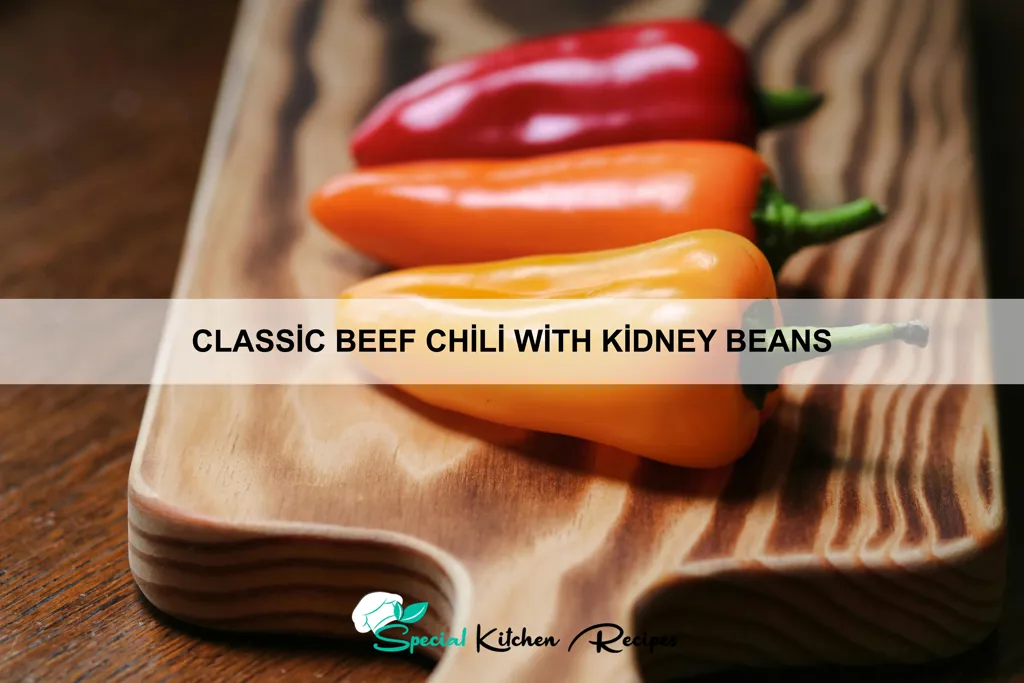Classic Beef Chili with Kidney Beans, a hearty and flavorful stew, boasts a rich history deeply intertwined with American culture, particularly that of the Southwestern United States. While pinpointing a single origin is difficult, its roots lie in the diverse culinary traditions of Spanish settlers and Native American communities who combined their cooking methods and ingredients. The chili we know today evolved over centuries, incorporating influences from Mexican cuisine and the readily available ingredients of the American West. Early versions likely lacked tomatoes, a staple in modern recipes, with the addition of this ingredient contributing to a significant shift in flavor profiles during the 19th and 20th centuries.
The exact timeline of chili’s development is debated, but its popularity exploded in the late 19th and early 20th centuries, fueled by westward expansion and the rise of chili cook-offs. These competitions, often held in Texas and other Southwestern states, helped to standardize certain elements of chili recipes while also celebrating regional variations. Today, chili cook-offs remain incredibly popular, drawing thousands of participants and spectators annually. In fact, the Terlingua International Chili Championship, one of the most prestigious events, draws competitors from across the globe, showcasing the universal appeal of this seemingly simple dish. The Terlingua Championship is a prime example of chili’s cultural significance, demonstrating its ability to unite people from diverse backgrounds through a shared passion for food and friendly competition.
Beyond its competitive aspect, chili holds a significant place in American culinary culture. It’s a staple dish at sporting events, tailgates, and family gatherings, symbolizing comfort, warmth, and community. Its adaptability is also a key factor in its enduring popularity; countless variations exist, ranging from mild and slightly sweet to intensely spicy and meaty. While beef is the most common protein, variations exist using turkey, chicken, or even vegetarian alternatives, showcasing its versatility and ability to cater to different dietary needs and preferences. The inclusion of kidney beans, a nutritional powerhouse rich in protein and fiber, further adds to the chili’s wholesome appeal, contributing to its enduring legacy as a beloved American classic.
Ingredients and Measurements
This recipe yields approximately 8 servings of Classic Beef Chili with Kidney Beans. Accurate measurements are crucial for achieving the perfect balance of flavors and textures. We recommend using a kitchen scale for the most precise results, especially for spices.
Beef: 2 lbs (907g) of chuck roast, cut into 1-inch cubes. Chuck roast is ideal for chili as it’s flavorful and relatively inexpensive. Avoid using leaner cuts as they will result in a drier chili. You can substitute with other beef cuts like brisket or short ribs, but adjust cooking time accordingly.
Aromatics & Spices: 1 large yellow onion, finely chopped (approximately 1 cup); 2 cloves garlic, minced; 1 red bell pepper, seeded and finely chopped (approximately 1 cup); 1 green bell pepper, seeded and finely chopped (approximately 1 cup); 2 tablespoons chili powder; 1 tablespoon ground cumin; 1 teaspoon smoked paprika; 1 teaspoon oregano; ½ teaspoon cayenne pepper (adjust to your spice preference); ½ teaspoon salt; ¼ teaspoon black pepper.
Liquids & Beans: 28 ounces (794ml) crushed tomatoes; 15 ounces (425g) kidney beans, canned and rinsed; 1 (15 ounce/425g) can of diced tomatoes, undrained; 1 cup beef broth (low sodium preferred); 1 tablespoon Worcestershire sauce; 1 tablespoon apple cider vinegar (adds depth of flavor).
Optional additions: For a richer flavor, consider adding 1-2 tablespoons of tomato paste along with the onions. A tablespoon of brown sugar can help balance the acidity. If you prefer a thicker chili, you can simmer it uncovered for a longer period to reduce the liquid. For a spicier chili, increase the amount of cayenne pepper gradually, tasting as you go.
Note on Kidney Beans: While canned kidney beans are convenient, you can use dried kidney beans for a deeper, more complex flavor. However, dried beans require pre-soaking and a longer cooking time (typically 1-2 hours). Remember to adjust the liquid accordingly if using dried beans.
Measuring Spices: For the most consistent results, use measuring spoons and a scale to measure your spices. Avoid using tablespoons or teaspoons from your spice jars as this can lead to inaccurate measurements.
Fresh Ingredients: Using fresh ingredients whenever possible will significantly enhance the overall flavor of your chili. Freshly chopped onions, garlic, and bell peppers will provide a brighter, more vibrant taste compared to pre-chopped or frozen options.
Equipment List
Making a delicious Classic Beef Chili with Kidney Beans requires the right tools to ensure even cooking and effortless preparation. This list details the essential equipment, along with recommendations for optimal results and alternatives where applicable.
Large Stockpot (6-8 quart): This is the workhorse of the chili-making process. A large stockpot, ideally between 6 and 8 quarts, provides ample space for all the ingredients and allows for even simmering. Avoid using pots significantly smaller, as overcrowding can lead to uneven cooking and sticking. A heavy-bottomed pot is preferable for even heat distribution, preventing hot spots.
Large Cutting Board (at least 12×18 inches): You’ll need a large cutting board to comfortably chop vegetables like onions, peppers, and garlic. A larger board minimizes the risk of cross-contamination and provides ample space for working with multiple ingredients simultaneously. Choose a durable cutting board made of wood or high-quality plastic that’s easy to clean.
Sharp Chef’s Knife (8-inch): A sharp chef’s knife is crucial for efficient and safe chopping. A dull knife requires more force, increasing the risk of accidents. Regular sharpening is essential to maintain its effectiveness and safety. Consider investing in a honing steel to maintain the sharpness between sharpening sessions.
Measuring Cups and Spoons: Accurate measurements are key to achieving the desired flavor profile. Use a set of measuring cups and spoons to accurately measure the spices, liquids, and other ingredients. Avoid using household spoons or cups, as their measurements may not be precise.
Wooden Spoon or Spatula: A sturdy wooden spoon or heat-resistant spatula is ideal for stirring the chili while it simmers. Avoid using metal utensils as they can scratch the pot’s surface, especially if it’s non-stick. A wooden spoon also helps to prevent sticking and allows for better control when mixing.
Ladle: A ladle is essential for serving the chili. It allows for easy and controlled portioning. A large ladle (at least 1 cup capacity) is recommended for serving generous portions.
Colander: A colander will be needed to drain the kidney beans before adding them to the chili. Choose a colander that is appropriately sized for the quantity of beans you are using to ensure efficient draining.
Can Opener: A reliable can opener is essential for opening the cans of diced tomatoes, kidney beans, and any other canned ingredients. A smooth-functioning can opener will make the process much easier and safer.
Optional: Immersion Blender (for a smoother chili): If you prefer a smoother chili texture, an immersion blender can be used to partially puree the chili after it has simmered. This is purely optional, but it can create a different mouthfeel.
Preparation Phase: Meat and Vegetables
The success of a classic beef chili hinges significantly on the preparation of its core ingredients: the meat and vegetables. Proper preparation ensures optimal flavor development and texture throughout the cooking process. We’ll be using 2 lbs of beef chuck, cut into 1-inch cubes, for a rich and hearty chili. Ensure your beef is at room temperature before browning; this promotes even cooking and prevents toughening.
Begin by trimming away any excess fat from the beef cubes. While some fat adds flavor, excessive fat can lead to a greasy chili. Aim for a balance – about 1/4 cup of fat should remain after trimming. Discard the excess fat responsibly.
Next, prepare the vegetables. We’ll need one large yellow onion (approximately 1 cup chopped), 2 cloves of garlic (minced), 1 green bell pepper (1 cup chopped), and 1 red bell pepper (1 cup chopped). Finely chopping the vegetables ensures even cooking and prevents large chunks from remaining uncooked in the final chili. Use a sharp knife for consistent chopping. A food processor can also be used, but be careful not to over-process and create a puree.
For added depth of flavor, we’ll use 2 tablespoons of chili powder, 1 tablespoon of cumin, 1 teaspoon of smoked paprika, 1 teaspoon of oregano, and 1/2 teaspoon of cayenne pepper (adjust to your spice preference). Combine these spices in a small bowl before adding them to the pot to ensure even distribution and prevent clumping. This blend will create a complex and flavorful base for your chili.
Once the vegetables are chopped, set them aside in a separate bowl. This will prevent them from prematurely wilting or releasing excess moisture before browning the beef. Proper organization is key to an efficient and enjoyable cooking process. Keeping ingredients separated until needed helps maintain their individual qualities.
Finally, before starting the browning process, ensure you have a large, heavy-bottomed pot or Dutch oven. This will promote even heat distribution and prevent sticking. A well-seasoned pot is also recommended for better browning and easier cleanup.
Cooking Techniques: Browning, Simmering
This section details the crucial browning and simmering techniques used in crafting our Classic Beef Chili with Kidney Beans. Proper execution of these steps is key to achieving a rich, flavorful chili.
Browning the Beef: Begin by browning 2 lbs of beef chuck, cut into 1-inch cubes. This is best achieved in batches to avoid overcrowding the pan and steaming the meat instead of browning it. Overcrowding lowers the pan temperature, resulting in boiled instead of seared meat. Use a large, heavy-bottomed pot or Dutch oven. Heat 2 tablespoons of vegetable oil over medium-high heat. Once the oil shimmers, add approximately 1/3 of the beef cubes, ensuring they’re not touching each other. Sear for 3-4 minutes per side, until a deep brown crust forms. Remove the browned beef from the pot and set aside. Repeat this process with the remaining beef in two more batches. Do not overcrowd the pan! This is critical for achieving a good sear.
Professional Tip: For an even deeper flavor, consider adding a tablespoon of tomato paste to the pot after browning each batch of beef. Allow it to cook for a minute or two, stirring constantly, to slightly caramelize. This adds a layer of umami richness to your chili.
Simmering the Chili: Once all the beef is browned, return it to the pot. Add 1 large chopped onion (about 1 cup), 2 cloves minced garlic (about 1 teaspoon), 1 green bell pepper, chopped (about 1 cup), and 1 (28-ounce) can of crushed tomatoes. Stir well to combine. Next, add 1 (15-ounce) can of kidney beans (drained and rinsed), 1 (15-ounce) can of diced tomatoes (undrained), 2 cups of beef broth, 2 tablespoons of chili powder, 1 tablespoon of cumin, 1 teaspoon of oregano, ½ teaspoon of cayenne pepper (or more, to taste), and 1 teaspoon of salt. Adjust seasoning to your personal preference.
Bring the chili to a gentle simmer over medium heat. Reduce the heat to low, cover the pot, and let it simmer for at least 2 hours, or up to 4 hours for a deeper, more complex flavor. The longer it simmers, the more the flavors will meld and deepen. Stir occasionally to prevent sticking. Remember to maintain a gentle simmer – a rolling boil will evaporate the liquid too quickly and result in a dry chili.
Important Note: If the chili becomes too thick during simmering, add a little more beef broth or water, as needed, to achieve your desired consistency. Before serving, taste and adjust seasoning as needed. Enjoy your delicious, homemade Classic Beef Chili with Kidney Beans!
Seasoning and Flavor Building
Seasoning a classic beef chili is crucial for achieving that deep, rich flavor we all crave. Don’t be shy with the spices; they’re the backbone of this dish! We’ll begin by building a flavorful base using aromatics before introducing the chili powder and other spices.
Start by finely chopping one large onion (approximately 1 cup) and two cloves of garlic (minced). Sauté these in 2 tablespoons of olive oil over medium heat until softened and translucent, about 5-7 minutes. This step is essential for developing a complex flavor profile. The onions and garlic will caramelize slightly, adding sweetness and depth to the chili.
Next, we’ll introduce the spices. Add 2 tablespoons of chili powder, 1 tablespoon of ground cumin, 1 teaspoon of smoked paprika, 1 teaspoon of oregano, 1/2 teaspoon of cayenne pepper (adjust to your spice preference), and 1/2 teaspoon of ground black pepper. Toast the spices in the pot for about 1 minute, stirring constantly, to release their aromatic oils. This simple step significantly enhances the flavor of your chili.
Now, it’s time to incorporate the beef. Stir in 1.5 lbs of ground beef, breaking it up with a spoon as it browns. Cook until the beef is browned and crumbled, about 8-10 minutes. Be sure to drain off any excess grease at this stage to prevent a greasy chili. This step also helps to concentrate the flavors.
For added depth, consider adding a bay leaf (remove before serving) and a teaspoon of brown sugar. The bay leaf adds a subtle earthiness, and the brown sugar balances the spices and adds a touch of sweetness to cut through the heat. Don’t underestimate the power of salt. Season generously with salt and pepper throughout the cooking process, tasting and adjusting as needed. Remember, you can always add more salt, but you can’t take it away!
Finally, a splash of your favorite liquid smoke (about 1/2 teaspoon) adds a smoky dimension that perfectly complements the other spices. Stir everything together well to ensure even distribution of flavor. This comprehensive approach to seasoning will result in a chili that’s complex, flavorful, and deeply satisfying.
Professional Tip: For an even richer flavor, consider using a combination of chili powders, such as ancho chili powder and chipotle powder, in place of some of the standard chili powder. This will add layers of flavor and complexity to your chili.
Blending (Optional)
While classic chili is known for its chunky texture, some prefer a smoother, more velvety consistency. This optional blending step allows you to customize your chili’s texture to your liking. Note: blending will significantly alter the chili’s final appearance and mouthfeel.
If you choose to blend, we recommend blending only a portion of the chili, rather than the entire pot. This allows you to achieve a desired level of thickness and maintain some of the original texture. For a partially blended chili, we suggest blending about 1/3 to 1/2 of the cooked chili. Start with a smaller amount and gradually add more until you reach your preferred consistency; it’s much easier to add more than to take away.
To begin, allow the chili to cool slightly before blending. Hot chili in a blender can be dangerous due to potential pressure buildup and splatter. Wait at least 30 minutes, or until the chili is lukewarm. Use a high-powered blender or an immersion blender for optimal results. If using a regular blender, work in batches to avoid overloading the motor. Add the chili to the blender in batches, leaving about 1 inch of space at the top to allow for expansion.
For a smoother texture, blend until completely smooth. For a slightly chunkier consistency, pulse the blender several times for shorter durations. Experiment to find your ideal texture. Once blended, carefully pour the blended chili back into the main pot and stir gently to combine with the unblended portion. Taste and adjust seasoning as needed; blending may slightly alter the flavor profile.
Important considerations for blending: If you’re using a high-fat chili, you may find that the blended portion is thicker and richer. You might need to add a little beef broth or water to adjust the consistency if it becomes too thick. Remember that the chili will thicken further as it cools. Always use caution when blending hot liquids. If you are unsure about using a regular blender with hot liquids, opt for an immersion blender as a safer alternative.
Whether you choose to blend or not, your chili will be delicious! Enjoy the versatility of this classic recipe and tailor it to your unique preferences.
Recommendations for Classic Beef Chili with Kidney Beans
This hearty Classic Beef Chili with Kidney Beans is best served hot, ideally straight from the pot or after a brief simmer to allow the flavors to meld further. For a truly satisfying meal, we recommend serving it in a bowl topped with your favorite garnishes. Consider adding shredded cheddar cheese, a dollop of sour cream or Greek yogurt, finely chopped red onions, and a sprinkle of fresh cilantro for extra flavor and texture.
For a more substantial meal, serve your chili with a side of crusty bread for dipping, or alongside a simple green salad to balance the richness of the chili. Cornbread is another classic pairing that complements the chili’s savory flavors perfectly. Alternatively, you could serve it over fluffy rice or mashed potatoes for a heartier option.
Storage is crucial for maintaining the quality of your chili. Allow the chili to cool completely before storing it in airtight containers in the refrigerator. It will keep for up to 4 days. You can also freeze the chili for longer storage; it can last for up to 3 months in the freezer. Remember to thaw it thoroughly in the refrigerator before reheating.
Nutritional Information (per serving, approximate): Calories: 350-400 (depending on ingredients and serving size), Protein: 25-30g, Fat: 15-20g, Carbohydrates: 30-40g, Fiber: 10-15g. Note: This is an estimate and may vary based on specific ingredients used and portion size. For precise nutritional information, use a nutrition calculator with your specific ingredients list.
Important Note: Always ensure your beef is cooked to a safe internal temperature of 160°F (71°C) to prevent foodborne illness. Adjust seasoning to your taste preference. Enjoy!





